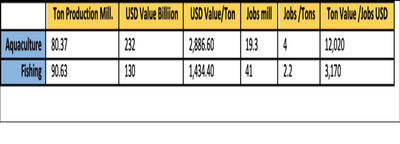 Aquaculture produces 73% more value per job than the Fishing Industry
Aquaculture produces 73% more value per job than the Fishing Industry
Editor:Mohamed shihab
During 2016, every job in the fishing industry produced USD$3,170.00, while in aquaculture every job produced USD$12,020.00.
In the last Aquaculture Report of the Fao Aquaculture Magazine –FAN-, written in October 2018, and edited by Valerio Crespi, Editor in Chief of the Aquaculture Department of the FAN, the value of aquaculture production is highlighted by categories. However, he clarifies that the value of the first sale of aquaculture products has been re-estimated, and the result has given higher figures than those previously estimated. The report clarifies that the available data to calculate the volumes of aquaculture production is more exact and reliable than the information available to calculate its value.
The report highlights that the total production of aquaculture products in 2016 was 80 million tons of fish and shellfish, valued at USD $ 231.6 billion, 30 million tons of aquatic plants with an estimated value of USD$11.7 billion and 37,900 tons of non-food products with a value of USD$213.6 million.
The total aquaculture production for direct human consumption that year was then 80 million tons, with a value of USD$232 billion, which represented the 47% of the total volume and 64% of the total value of the year´s aquaculture and fishing world production. Aquaculture products were worth more than the fishing products.
Although global aquaculture continues to grow faster than other food production sectors, the report points to the fact that the elevated rates of the 1980s and 1990s´ annual growth (11,3% and 10,0%, aquatic plants excluded) are no longer seen, and concludes that the average annual growth fell to 5.8% during the period of 2000 to 2016.
Of the 80 million tons produced in 2016: 54.1 million corresponded to fish, 17.1 to mollusks, and 7.9 to crustaceans (there being another 930 thousand tons of other species). China, which is the largest aquaculture producer in the world, has produced more aquaculture products than the rest of the world since 1991. Other stand-out producers in 2016 where Vietnam, Bangladesh, Egypt and Norway.
30% of the total 2016 aquaculture production were unfed species such as: carps (8.8 million tons) and bivalve molluscs (15.6 million tons), totaling 24.4 million tons. For this report, the marine bivalves and algae are described as “extractive species.” The production of extractive species represented 49.5% of the global aquaculture total production of 2016.
The report highlights that 19.3 million people worked in aquaculture in 2016, 47% of those who worked in fishing that same year. Following these numbers, every job in fishing produced USD$3,170, while every aquaculture job produced USD$12,020. Jobs in aquaculture produced 83% more value than those in fishing in 2016.
In this context, it would be worth considering that, when it refers to investing money in sustaining or increasing the production of fish and seafood through means of direct investments or subsidies, it is far more convenient to invest in a more efficient activity in which products are marketed with greater value, such as aquaculture, rather than investing in a low-efficiency production chain in which products are not always well-valued because of their seasonality and their reduced variety of presentation and added value, as is the case with products from fishing; not to mention the lack of cold and traceability chains for fishing products in many cases. Society should be best informed about this matter, and their chamber- and parliament representatives, in order to decide where they prefer to invest.


ساحة النقاش